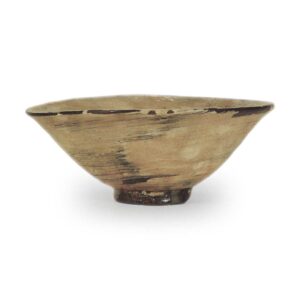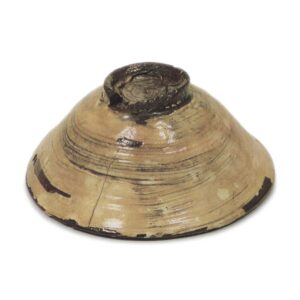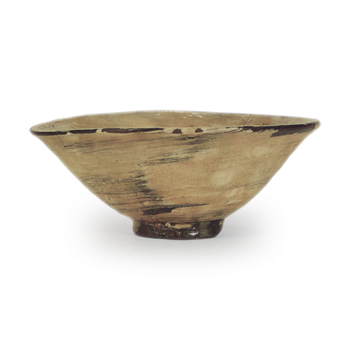

Collection: Fujita Art Museum
Height: 5.0 – 5.4 cm
Diameter: 12.5 – 13.0 cm
Base diameter: 4.0 cm
Height: 0.8 cm
The shape of the handle is similar to that of the Gaho, and the sharpness of the blade is excellent. When we think of Mishima and Hakeme, we think of the Gyeryongsan (in Chungcheongnam-do), but this is a good example of the style of that work, crystallized in a straightforward way.
The life of Hakeme is, of course, in the speed of the Hakeme, like a rapid stream or a gale. In the case of Keiryu-zan, the light and sharpness of the work also adds to the effect, and the more you look at it, the more the brush marks flow with a pleasant rhythm, and you are struck by the illusion that the tea bowl itself is beginning to rotate. The works of Keiryuuzan have long been favored by tea masters for their sharpness, but this appeal is particularly strong in the brush marks.
Traditionally, the tastes of tea masters have been symbolized by tranquility, but when you look closely, is it really just a superficial tranquility? Even the still blue depths of a pond are in fact teeming with movement, and the stillness that seems to be a calm and tranquil blue surface can actually be blown violently by a gust of wind. It seems that the real taste of a great tea master is to be found in the stillness that conceals movement. The tea masters’ lamentations over the poverty of the tea utensils and the famous bowls, such as the Iroha and Kakinoju, are all of this type, and there is no doubt that they will always respond to the sharp nerves of the tea masters, who have been honed and refined to the utmost.
In other words, it is clear that the tea master’s sense is fundamentally keen and sharp, and it is highly plausible that he would have appreciated the dynamic and sharp patterns of brush marks, such as the Keiryu-zan brush mark, from an early stage.
The clay is particularly thin, and the work is light and well-defined, giving it a sharp, incisive feel overall. The inside and outside are covered in vigorous brush marks, leaving the foot ring untouched, and the inside in particular has a powder-like finish, giving it the appearance of a plain brush mark, but the lively characteristics of the Kiryuzan brush mark are fully expressed on the outside, and it is deeply captivating. There are five traces of brush marks visible in the interior, and there are some white spots on the exterior surface. The foot ring is also small and tightly made, which is characteristic of the Kiryuzan style, and there is a large crack in the rim, but this actually adds strength to the work and deepens its appeal. There are still three five-pointed star marks visible on the foot ring, and the helmet is standing up sharply, with a crack inside. The black clay of the body makes the white brush marks on the foot ring stand out even more. There are some areas where the white has peeled off around the rim, but this actually adds to the overall effect. There is a long vertical crack running down the center.
Accessories:
Bag, Mochizuki Kanto
Inner box paulownia wood, plain finish, calligraphy by Kobori Enshu “Hame tea bowl
Outer box black lacquer, chamfered, gold powder lettering ‘Hake tea bowl
General box Shunkei, silver powder lettering ’Famous Hame tea bowl
It was passed down in the Fujita family and is now in the collection of the Fujita Art Museum.



